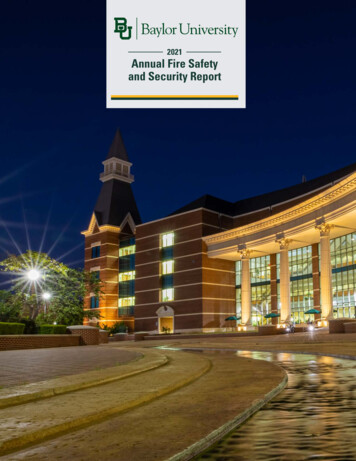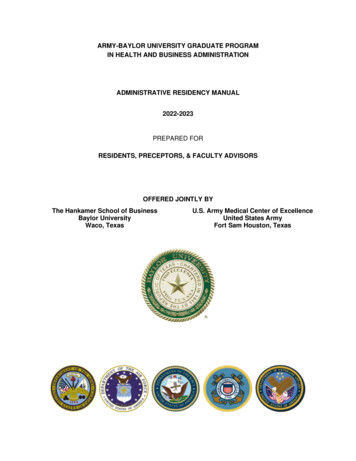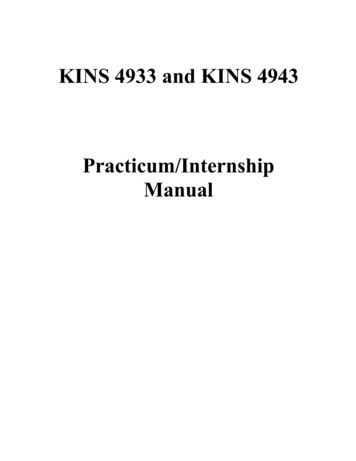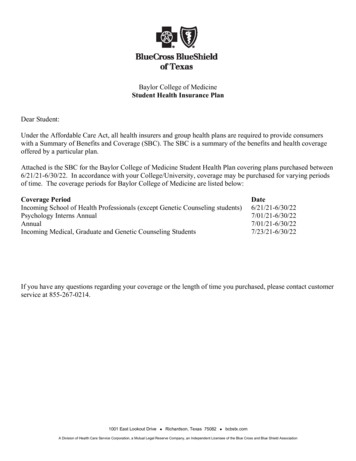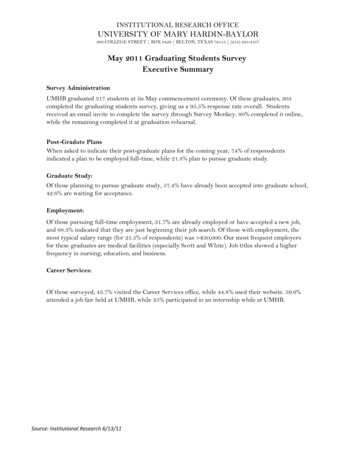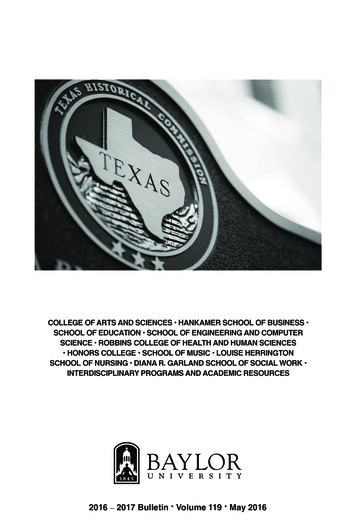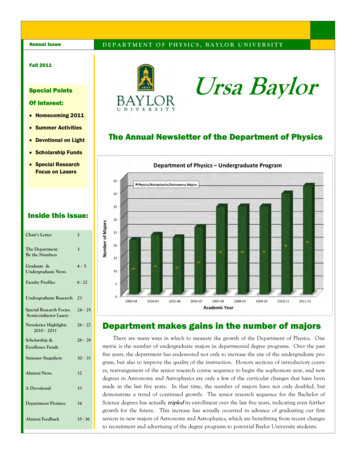
Transcription
Annual IssueDEPARTMENT OF PHYSICS, BAYLOR UNIVERSITYFall 2011Ursa BaylorSpecial PointsOf Interest: Homecoming 2011 Summer Activities Devotional on LightThe Annual Newsletter of the Department of Physics Scholarship Funds Special ResearchFocus on LasersInside this issue:Chair’s Letter2The DepartmentBy the Numbers3Graduate &Undergraduate News4- 5Faculty Profiles6 - 22Undergraduate Research 23Special Research Focus:Semiconductor Lasers24 - 25Newsletter Highlights2010 - 201126 - 27Scholarship &Excellence Funds28 - 29Summer Snapshots30 - 31Alumni News32A Devotional33Department Pictures34Alumni Feedback35 - 36Department makes gains in the number of majorsThere are many ways in which to measure the growth of the Department of Physics. Onemetric is the number of undergraduate majors in departmental degree programs. Over the pastfive years, the department has endeavored not only to increase the size of the undergraduate program, but also to improve the quality of the instruction. Honors sections of introductory courses, rearrangement of the senior research course sequence to begin the sophomore year, and newdegrees in Astronomy and Astrophysics are only a few of the curricular changes that have beenmade in the last five years. In that time, the number of majors have not only doubled, butdemonstrate a trend of continued growth: The senior research sequence for the Bachelor ofScience degrees has actually tripled its enrollment over the last five years, indicating even furthergrowth for the future. This increase has actually occurred in advance of graduating our firstseniors in new majors of Astronomy and Astrophysics, which are benefitting from recent changesto recruitment and advertising of the degree programs to potential Baylor University students.
Ursa BaylorPage 2From the Chair October 2011Dear Friends,Dr. Greg BeneshChairmanDepartment of PhysicsGreetings from the Baylor Physics Department! The fall semester is underway, and there is at leasta hint that cooler temperatures are in the offing. It was a record summer in Waco this year, asmany of you know, with 90 days of 100-degree weather. As a result, our annual Physics Department Picnic was moved from the first week of classes (when the temperature was forecast to be110 F) until Sept. 16th. We thank the second-year graduate students for making the picnic a bigsuccess!We have plenty of new people to welcome this year: one new faculty member, one new (full-time)staff member, eighteen new undergraduate majors, and five new graduate students. Our new faculty member is Daniel Bolton, who comes to us from the University of Washington, and fills theLecturer position vacated by Ed Schaub. We also have a new laboratory coordinator, Randy Hall,who replaces Linda Kinslow in that position.“We hope to seemany of you atHomecoming onNovember 4th and5th.”- Greg BeneshIf you drop by the Department this fall, be sure to see the new Graduate Student Study Area! Wehave recently converted a room for the exclusive use of our graduate students. So far, it has lots ofwork space, white boards, a couple of sofas, a printer, and a coat rack. There is plenty of room forgroup projects and late-night conversations.Over the summer, Dr. Zhenrong Zhang‘s new first-floor laboratory became operational. Her scanning tunneling microscopy lab was worthy of a front page Lariat article in the first issue of the academic year. The STM images of TiO2 are simply stunning—with individual atoms clearly imaged.We plan to include a public grand opening of her lab during Homecoming activities—so be sure toattend!On August 19th, the Department gathered for our Fall Faculty Retreat/Workshop. We have beenconducting these sessions the past three years to briefly review the progress made in the previousyear, and then to make plans for the upcoming year. Some of the items marked for emphasis thisyear are the astronomy/astrophysics program—which is in need of faculty positions, making plansfor a Baylor planetarium and observatory, re-formulating our advisory board, taking steps to increase our grant proposal success, revising our department‘s strategic plan as the University movesbeyond 2012, and developing a departmental giving initiative. Jeff and Linda Olafsen have kickedoff the latter with a generous gift to the Physics Department‘s Endowed Excellence Fund. We arehoping that other faculty members will meet their challenge gift—and then, later this fall, we plan totell you more about it!We again thank you for your interest and support. Please continue to pray with us that we honorGod in all of our work, and that we accomplish goals that are pleasing to Him. We hope to see youat Homecoming on November 4th-5th . We have scheduled the Grand Opening of Dr. ZhenrongZhang‘s Scanning Tunneling Microscopy Lab on Friday afternoon, Nov. 4th, in room C.161R ofthe Baylor Sciences Building from 3-4 p.m. That will be followed by our annual Physics Homecoming Reception in BSB room E.301 from 4-6 p.m.With warmest best wishes,The Annual Message fromthe ChairGreg BeneshProfessor & Chairman
Annual IssuePage 3The Department by the NumbersNumber of Full-time Faculty: 18Tenured or Tenure-Track Faculty: 15Lecturers: 3Undergraduate Physics, Astronomy & Astrophysics Majors: 41The Department benefitsfrom prestigious visitors togive colloquia on exciting,contemporary physics.Physics Graduate Students: 29Postdoctoral Fellows: 52010 - 2011 EnrollmentsNumber of Students Enrolled in Physics Classes: 2469Summer 2010: 82Fall 2010: 1162Spring 2011: 1225“If you drop by theDepartment thisNumber of Students Enrolled in Undergraduate Laboratories & Tutorials: 2702Summer 2010: 72Fall 2010: 1266Spring 2011: 1364Number of Undergraduate Laboratory & Tutorial Sections: 140Summer 2010: 8Fall 2010: 62Spring 2011: 70fall, be sure to seethe new GraduateStudent StudyArea!”- Greg BeneshIn 2010 - 2011:Number of Funded Grants: 19Scholarly Publications (including Conference Proceedings): 144Conferences attended by Department Members: 41US News & World Report‘s average ranking of the national universities from which ourtenured and tenure-track faculty received their PhD degrees: 25US News & World Report‘s Department Ranking: 113Academic Analytics Department Ranking: 70National Research Council Department Rankings: R-Rank range: 96 - 147S-Rank range: 118 - 149Making “Liquid Nitrogen”Ice Cream at the Fall Picnic
Ursa BaylorPage 4The Graduate ProgramDear Physics Alumni and friends,I would like to extend a warm welcome to all Baylor Physics people at this Homecoming season!The Fall Picnic is one waythe Faculty and the newgraduate students get tospend some social timetogether.Our graduate program continues to be vibrant and active. Many improvements in the graduateprogram of study at Baylor have been incorporated. The Department has been very productive overthe past year, graduating 5 new PhD students and 2 new MS students. We admitted 5 new physicsgraduate TAs this year. A new graduate student study area has been opened up in the Physics research wing. We continue to lead the university in the number of papers published per student bya wide margin. Our annual graduate stipend is now in excess of 20,000 for the first time. In addition, one new student TA position was added this year.“Gratifyingly, theThe Physics graduate program has incorporated a number of changes in graduate recruitment pro-total number ofproved physics website has been active the entire recruiting cycle this time. This site is both moresubmitted [graduate]specifically targeted it to new international and domestic locations. Along with this, we adopted acedures this year that have helped attract more and better applications. First, our new and imattractive and more informational. Second, a new graduate poster was printed and distributed. Wemore aggressive emailing campaign based upon obtaining lists of students who had taken theapplicationsincreased by 57%over last year.”- Walter Wilcoxphysics subject GRE exam. Another important ingredient was our new Speaker Outreach Program(SOP). Each of the graduate faculty has been assigned two colleges or universities in Texas. Letterswere sent out offering our faculty for research talks at the schools. These talks have helped communicate the excitement and interest we have in our research fields, and have increased the communication between the various physics programs. We think Baylor Physics will gain from this newprogram in the form of increased graduate student interest and applications. Our newest enhancement in graduate recruiting was the first Physics Recruitment Weekend, held on Feb. 25 and 26.The event brought 10 potential graduate students to campus to meet with faculty, tour the department and learn more about the graduate program in physics at Baylor. These efforts were verygenerously supported by the Baylor Graduate School. Gratifyingly, the total number of submittedapplications increased by 57% over last year. We seem to be on the right track!We are grateful for the opportunity to teach and produce new knowledge at Baylor University. Weare having a positive impact on the people, ideas and our community.Very best wishes,Physics Graduate Studentsbenefit from Departmental(Wednesdays) & Graduate(Fridays) Colloquia.Walter WilcoxProfessor and Graduate Program Director
Annual IssuePage 5The Undergraduate ProgramDear Alumni and Friends of the Department of Physics,One of the most frequent questions asked of me by prospective physics students is ―What can I dowith a physics major?‖ It‘s a terrific question. Considering the current state of the economy, andthe plight of many who are desperately seeking employment, it makes good sense for all undergraduates to think hard about how their choice of major will affect their ability to pursue a fulfilling career after graduation.I believe a very appropriate answer to ―What can I do with a physics major?‖ is anything you want todo. An education in physics teaches you how to think. By learning skills in problem solving, mathematical reasoning, computer programming, and organizing and interpreting data, students canmove into all kinds of jobs that require an ability to think logically and creatively. While some graduates who earn a degree in physics go on to become professional physicists, the majority pursuescareers in fields where they can put their knowledge to a wide variety of practical applications.Nearly 90% of all ―physicists‖ are working in medicine, education, industry, or other professions.Physics graduates are in demand for their analytical skills, and their ability to tackle real-life problems make them highly attractive to employers.Here at Baylor, we are pleased to offer our students exactly this kind of solid education in physics,astrophysics, or astronomy. Our program has been growing each year, and this fall we welcome thelargest incoming class of new freshmen and transfer students – 18 total!Our new astronomy and astrophysics degree programs are starting to attract considerable attentionfrom prospective students. Majors in astronomy and astrophysics begin their coursework togetherwith physics majors and later branch out into more specialized courses. We currently have 12 students studying astrophysics and astronomy. This semester we are offering PHY 4150 (InstructionalObserving) and PHY 4350 (Introduction to Stellar Structure and Evolution) for the first time. PHY4351 (Introduction to Modern Cosmology) will be offered next spring. The department is awaitingadministrative approval to hire additional tenure-track professors, and astronomy/astrophysics isone of the target areas for expansion.St udentscel e bratin ggraduation at a receptionhosted by the Departmentin May 2011.“An education inphysics teaches youhow to think.”- Jay DittmannWe are especially pleased to congratulate five of our students who completed either a B.A. or B.S.degree in physics during 2010–2011: Gilberto Villela, David George, Ian Reeves, Roxy Stein, andAndrew Yost.We are truly thankful for our students. Together, let us help them. Please consider a contributionto support undergraduate scholarships in the Department of Physics. We would also love to hearyour experiences with regard to careers in physics. As students ponder their many career optionsand reflect on the question ―What can I do with my physics major?‖, your stories could have a profound impact!With warm regards,Jay R. DittmannAssociate Professor and Director of Undergraduate StudiesWe benefit not only fromthe research facilities inthe BSB (Baylor SciencesBuilding) but also generousspaces for student study.
Ursa BaylorPage 6Faculty Research ProfilesWickramasinghe Ariyasinghe (Ari)Associate Professorthree areas: (i) stopping power, (ii) calculation of mean ionization potentials, and (iii) energy straggling. The model is excellent for predictingqualitative features of various parameters, although certain quantitativelimitations are clearly revealed.Publications:Research Interests:Atomic & molecular physicsAuger electron spectroscopyElectron scatteringAn empirical expression for total scattering cross sections of normalhydrocarbons, and experimental cross sections of C3H4 and C4H6,W. M. Ariyasinghe and G. Vilela, Nucl. Inst. and Meth. Phys. Res. B268, 2217 – 2220 (2010) .Electron scattering from alkenes in the energy range 200 – 4500 eV, P.Wickramachchi, P. Palihawadana, G. Villela and W. M. Ariyasinghe, Nucl. Inst. and Meth. Phys. Res. B 267 (2009).Dr. W. Ariyasinghe engages in atomic and molecular physics experiments. The department has several electron beam facilities (20 eV to 10KeV energy) for studying interactions of low energy and intermediateenergy electrons with atoms and molecules. He utilizes these facilitiesto measure the total electron scattering cross sections, the most reliableexperimental scattering cross section, of atoms and molecules at lowand intermediate energies. Accurate measurement in this region ofenergies requires extremely good energy and angular resolution to avoideffects due to forward-scattered electrons. With this in mind, he hasdeveloped an experimental station to measure the total cross sectionaccurately. Recently, he has been studying the total electron scatteringTotal Electron Scattering Cross Sections of alkanes at intermediateenergies, W. M. Ariyasinghe, P. Wickramarachchi, and P. Palihwadana, Nucl. Inst. and Meth. Phys. Res. B 259, 841 - 846 (2007) .Total electron scattering cross sections of Kr ans Xe in the energy range250 - 4500eV with C. Goains, Phys. Rev. A 70, 1050294 (2005).Electron scattering cross sections of He, Ne and Ar at intermediateelectron energies with C. Goains, D. Powers, T. Wijerathna and P.Phalihawadana, Nucl. Inst and Meth. Phys. Res. B 225, 191 - 197(2004).cross section of hydrocarbons and fluorocarbons, research of great importance to astrophysics, atmospheric physics, chemical physics, plasmaTotal electron scattering cross sections of CH4 and NH3 molecules inthe energy range 400 - 4000eV with T. Wijerathna and P. Paliha-physics, bio-medical physics, and semiconductor physics. His goal inthis area of research is to provide an accurate pool of total electronwadana, Nucl.Inst and Meth. Phys. Res. B 217, 389 - 395 (2004).scattering cross sections for the users in the above fields and industry.The past research involves the use of Auger electrons produced byheavy ion bombardment (protons and He ions) of small organic molecules to study the effect of chemical bonding on normal and satellitelines produced by the impinging ions. The study of heavy ion inducedAuger spectroscopy continued to produce the K-shell and L-shell ionizations cross sections (an essential tool in understanding the interactionmechanism between energetic ions with atoms or molecules) of all second and third raw elements in the periodic table. In addition, Dr.Ariyasinghe conducted experiments to investigate the isotropic/anisotropic nature of heavy ion induced Auger emission.For several years, Dr. W. Ariyasinghe and collaborators have beeninvolved with the slowing of He ions in thin films of vapor-depositedelemental matter and in gases to study the degenerate electron gasmodel of Jens Lindhard (a student of Niels Bohr in Copenhagen) inTotal electron scattering cross sections of PH3 and SiH4 molecules inthe energy range 90 – 3500eV with T. Wijerathne and D. Powers.Phys. Rev. A 68, 032708 (2003).Total electron scattering cross sections of CF4 and C2F6 in the energyrange 100 – 1500 eV Journal of Rad. Phys. Chem. 68, 79 (2003).Total electron scattering cross seections of CH4, C2H2, C2H4 and C2H6in the energy range 200-1400 eV with D. Powers, Phys. Rev. A 66,052723 (2002).Absolute K-shell ionization cross-section measurements of B producedby 0.4 - 2.0 MeV H and He ions and by .6 - 1.2 MeV H2 ionswith D. Powers, Phys. Rev. A 59, 1291 (1999).K-shell ionization of B,O, and F by 0.4-2.0 MeV He ions, with A. Ghebremedhin and D. Powers. Phys. Rev. A 53, 1537 (1996)
Annual IssuePage 7Faculty Research ProfilesGregory A. BeneshProfessor & ChairDepartment of Physicsregion‘s Hamiltonian, which causes the wave function solutions tomatch in amplitude and derivative to solutions in the substrate acrossan embedding surface. The Surface Embedded Green function (SEGF)method has proved to be extremely accurate for determining work functions and the energetics of surface states and resonances. Further refinements and extensions of the method, including time-dependent embedding, are under development.Research Interests:Surface Electronic StructureEmbedding ProblemsGravitational CollapseCurrently, Dr. Benesh is focusing attention on several surfaces ofrhodium and silver. The Rh(111) surface is particularly interestingsince the surface and subsurface shifts are in opposite directions! Obviously, contributions other than from charge transfer play an importantrole, because no charge transfer is expected between neighboring rhodium atoms. In fact, it is believed that the environmental effect (causedby the reduced coordination of surface atoms) is at least as important asProfessor Greg Benesh's research deals primarily with embeddingcharge transfer. There is also a relaxation (final-state) contribution thatproblems. In metal surfaces the redistribution of charge upon adsorption of atoms or molecules determines the nature of the surface chemi-is caused by the different screening properties of surface and bulk atoms.cal bond. Charge redistribution also causes changes in surface workfunctions and affects the core-level binding energies of atoms near theadsorption site. Many metal surfaces, such as those of platinum, tungsten, silver, and gold, display spontaneous phase transitions from thebulk crystal structure to a new structure once the surface is created. Therole that electrons play in such transitions is under investigation. Metalsurfaces also serve as catalysts for important chemical reactions. Therate at which interactions progress can often be enhanced by introducing different metal catalysts or by exposing a different crystal face of thesame metal. Current research focuses on the face-dependent catalyticactivity of various metal surfaces, and the nature of inter-atomic forceson surface atoms.One of the drawbacks of many surface calculations is the problemof interacting surface states across a thin slab; another is the neglect ofbulk electron states which affect the energies of surface states and surface resonances. The analysis of a surface system can be formulatedmore generally as an embedding problem: how to find the properties ofan interacting system of particles that is subject to boundary conditionsimposed by an underlying medium. Examples of embedding problemsinclude local magnetic moments arising from transition metal impurities in paramagnetic crystals, vacancies, chemisorbed molecules on surfaces, and surfaces themselves—which are merely two-dimensional impurities in a three-dimensional crystal. Professor Benesh and collaboratorshave developed a computational technique in which the surface atomiclayers of a crystal are embedded onto the semi-infinite bulk substrate bymeans of an embedding potential derived from the bulk Green function. The embedding potential is an additional term in the surfaceDr. Benesh has recently been collaborating with Prof. RogerHaydock of the University of Oregon on a project that employs themaximum breaking of time-reversal symmetry (MBTS) boundary condition to embed systems of interest. Prof. Haydock and Dr. C.M.M. Nexhave previously derived the MBTS condition for single bands in discrete systems. The current project focuses on a boundary condition forcontinuous wavefunctions when a finite system is being embedded intoan infinite one. The conditions for one- and two-band continuoussystems have now been derived, and we are presently applying the condition to different model potentials.On the lighter side, Dr. Benesh is also interested in the physics ofeveryday phenomena—including the positioning of a gazebo to mark thesummer solstice, the death of Spider-Man‘s original girlfriend GwenStacy, the drowning of Charlie in the underwater (Looking Glass) station on the television series LOST, and the results of various MYTHBUSTERS tests. Dr. Benesh has recently submitted a paper with Dr.Jeffrey Olafsen on the results of a theoretical and experimental study ofthe stability of a can of soda (Dr Pepper , of course!) on an acceleratinghorizontal surface—such as the dashboard of a car.Select Publications:Homothetic Self-similar Solutions of Three-Dimensional Brans-DickeGravity, Gen. Relativ. Gravit. 39, 277 - 289 (2007).Asymptotes of Solutions of a Perfect Fluid Coupled with a Cosmological Constant in Four-Dimensional Spacetime with Toroidal Symmetry,With Anzhong Wang. Gen. Relativ. Gravit. 38, 346 (2006).
Ursa BaylorPage 8Faculty Research ProfilesGerald Bryan CleaverAssociate ProfessorResearch Interests:String/M-theory phenomenologyString/M Landscape A Systematic, Statistical Search of Gauge Content in Free Fermionic Heterotic String Models Systematic Extensions of the NAHE and NAHE Variation in theFree Fermionic String Landscape On the Correlation of Extra MSSM Higgs to Stringent Flat Directions in Heterotic String Theory.Additional Scholarly Activities:Dr. Cleaver is the Associate Editor of the Journal of Physics, and theString Model BuildingJournal of Astrophysics and Physical Cosmology. He is a referee for ModernString CosmologyPhysics Letters A, General Relativity and Gravitation, ISRN MathematicalPhysics, Physics Essays, and Scientific Research and Essays.Dr. Gerald Cleaver‘s research specialty is superstring theory, whichunifies all forces in nature (gravity, electromagnetics, and the strong andSelect Recent Publications:weak nuclear forces). In superstring theory each elementary particleoriginates as a distinct vibration of a single type of string (or loop) ofRedundancies in Explicitly Constructed Ten Dimensional Heteroticenergy, much as different musical notes are produced from a singleviolin string. Dr. Cleaver's current research topics include the construction of phenomenologically realistic superstring models, string/Mtheory cosmology, and the string landscape. Dr. Cleaver‘s researchgroup is conducting a long-term systematic study of the global physicalproperties of the string landscape in the free-fermionic heterotic region.Current members include Ph.D. students Jared Greenwald, DouglasMoore, and Yanbin Deng. Past members include former lecturer andpostdoc Dr. Tibra Ali (now at the Perimeter Institutue), Ph.D. studentsJohn Perkins (at AMD), Richard Obousy (member of Tau Zero project),Matt Robinson (private consultant), Tim Renner (August 2011 graduate), and M.S. students Kristen Pechan (Ph.D. student at Texas A&M),and Ben Dundee (Fincad in Vancouver, B.C.).Dr. Cleaver was invited to be a member of the Texas EducationAgency‘s State Review Panel for Supplemental Science Material Adoption. The panel met June 13-17 in Austin to review material(predominantly software and interactive websites) submitted to the TEAby publishing companies to supplement traditional textbooks for highschool physics, chemistry, biology and integrated physics/chemistrycourses. He was on a committee evaluating physics and integrated physics/chemistry material. The review process verifies that the submissionsmet the minimum content guidelines as set forth by TAKS standards.Texas school districts choosing to use TEA-approved material receive aString Models, with T. Renner, J. Greenwald, and D. Moore.arXiv:1107.3138. Submitted to Modern Physics Letters A.Systematic Investigations of the Free Fermionic Heterotic String GaugeGroup Statistics: Layer One Results. with D. Moore, J. Greenwald,T. Renner, M. Robinson, C. Buescher, M. Janas, G. Miller, and S.Ruhnau. arXiv:1107.5758, Submitted to Modern Physics Letters A.Investigations of Quasi-Realistic Heterotic String Models with ReducedHiggs Spectrum, with A. Faraggi, J. Greenwald, D. Moore, K.Pechan, E. Remkus, and T. Renner, arXiv:1105.0447. Submitted toInternational Journal of Modern Physics A.Note on a NAHE Variation, with Jared Greenwald, Douglas Moore,Kristen Pechan, Tim Renner, and Tibra Ali, Nucl. Phys. B 850(2011) 445-462.Branes in the MD x Md x Md- Compactifications of Type II String onS1/Z2 and Their Cosmological Applications, with Michael Devin,Anzhong Wang, and Qiang Wu. arXiv:0907.1756 [hep-ph], JHEP0915 (2009) 1756.A Non-Standard String Embedding of E8, with R. Obousy and M. Robinson, arXiv:0810.1038 [hep-ph]. Mod. Phys. Lett A 24 (2009) 15771582.partial reimbursement from the TEA for the cost for the material.Books:Conferences:First Principles and the Standard Model, with M. Robinson, K. Bland,J. Dittmann, and M. Serna. Published by Springer, August 2011. (FirstCleaver‘s research group presented three papers at the String VacuumProject Fall 2010 (Nov. 5-8) meeting at Ohio State University:in a 3 to 7 volume series.)
Annual IssuePage 9Faculty Research ProfilesJay R. Dittmanninto the CMS collaboration was an acknowledgment of the group‘ssignificant contributions to the research field. As Dr. Dittmann‘s re-Associate Professorsearch on the CDF experiment ramps down, and his Ph.D. studentscomplete their degrees, he will become increasingly involved on theDirector of Undergraduate StudiesCMS experiment.Research Interests:High Energy Physics / The Higgs BosonElementary Particle PhysicsFermilab Tevatron ColliderLarge Hadron Collider at CERNThe CDF and CMS ExperimentsThe Baylor HEP group reached a tremendous milestone in May2011 with the graduation of Drs. Samantha Hewamanage and MartinFrank, the group‘s first Ph.D. students. Sam searched for ―anomalous‖physics in proton-antiproton collisions in which a photon is producedwith "jets" of energetic particles. Upon graduating, Sam began a newpostdoctoral research position at Florida International University working on the CMS experiment. Martin was a key player in the quest todiscover the infamous Higgs boson in the WH channel, and his resultsThe primary goal of High Energy Physics (HEP), often called Elemen-improved the experimental limits on Higgs boson production. Martinhas moved on to a postdoctoral research position at the University oftary Particle Physics, is to discover the elementary constituents of matterand energy, probe the interactions between them, and explore the basicVirginia, where he pursues experimental HEP on the NOvA and Mu2ecollaborations.nature of space and time.As the first experimental HEP physicist at Baylor, Dr. DittmannDr. Dittmann currently works with two other Ph.D. students, KarenBland and Zhenbin (Ben) Wu, who are busily engaged in data analyseslaid the foundation for a new research program and built up a HEPgroup from scratch. Since its beginning in 2003, the experimental HEPfor their Ph.D. theses. Karen is actively investigating the case where aHiggs boson decays into two photons. Her work, together with that ofgroup has grown tremendously and is involved in several cutting-edgeBaylor‘s CDF postdoc, Dr. Kasmi, has captured the attention of theinternational HEP community, and a manuscript based on their workresearch projects. The group currently consists of nine members including Dr. Dittmann and Dr. Kenichi Hatakeyama, two postdoctoralhas recently been submitted to Physical Review Letters. Ben is studyingresearch associates (Drs. Azeddine Kasmi and Hongxuan Liu), and fourgraduate students. In addition, over the years, about 15 undergraduatesthe production and decay of top quarks, particularly rare cases where atop quark is produced by itself instead of in conjunction with an anti-have participated in experimental HEP research for honors theses, senior research projects, and summer internships.particle partner. Ben is one of the key players on this analysis at CDFand he has given multiple presentations of his work at CDF collabora-Dr. Dittmann leads Baylor‘s HEP research at Fermilab in Batavia,IL, where Baylor is affiliated with the world-renowned Collider Detec-tion meetings.Dr. Dittmann is a member of the Executive Board of the CDF Col-tor at Fermilab (CDF) experiment. Despite its success for over 25 years,the experiment has recently ceased the collection of new data. The lastlaboration at Fermilab. He is a co-author of many publications in Physi-proton-antiproton collisions in the Tevatron collider at Fermilab occurred on September 30, 2011. Nonetheless, plenty of data remains toHigh Energy Physics group at Baylor has been provided over the yearsbe analyzed, and the CDF experiment will continue to publish newresults for a few years.In anticipation of the end of the Tevatron at Fermilab, the BaylorHEP group has actively pursued other experimental collaborations. In2010, Baylor created a new affiliation with the CMS experiment atCERN, the location of the Large Hadron Collider (LHC) in Geneva,Switzerland. As a relatively small university group, it was an honor tobe accepted into a world-class exper
seniors in new majors of Astronomy and Astrophysics, which are benefitting from recent changes to recruitment and advertising of the degree programs to potential Baylor University students. D E P A R T M E N T O F P H Y S I C S , B A Y L O R U N I V E R S I T Y . Fall 2011 . Annual Issue . Special Points . Ursa Baylor . Of Interest:


